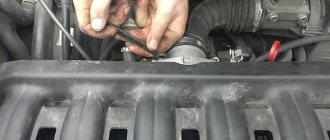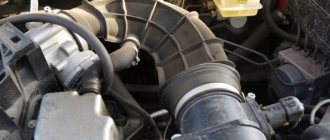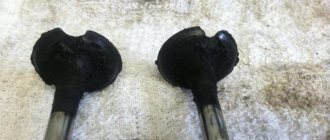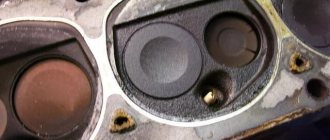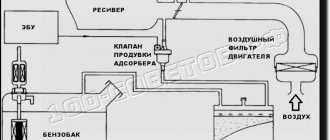Internal combustion engines require a mixture of air and fuel to operate. The flammable compressed mixture pushes the pistons, which turn the crankshaft, and the car begins to move. Air enters the engine through a small throttle valve. And to control auxiliary devices, a vacuum is created.
Consequences of air leaks
An air leak will cause unwanted air to enter the engine where it is not intended. This reduces engine performance and causes some systems that rely on vacuum to malfunction.
Because air leaks cause engine inefficiency, you will notice the "Check Engine" light on your dashboard. You will also experience acceleration problems - this is because fuel is not delivered efficiently to the combustion chambers. Vacuum is used to operate actuators, sensors or brakes.
If there is a vacuum leak, some of the sensors may begin to malfunction, forcing you to make unnecessary repairs.
How to find the leak location
There are 3 main methods by which you can find a leaky area:
The smoke itself created by such an installation is quite thick and quickly fills the entire system. All that remains for the motorist is to carefully monitor the place where the smoke is coming out, and after detecting it, carry out repair work.
In some cases, the leak can be found without additional means - the damaged area can be easily detected by the characteristic whistle or hiss that is produced by the intake air when the engine is running. True, this only happens if there are serious cracks and breaks.
If the proposed method using a smoke generator is not suitable (for example, there is no compressor available), then the test can also be performed using volatile flammable liquids packaged in pressurized cans. As such, you can use ethyl ether (although it is almost impossible to get it in its pure form now), a means for winter starting diesel engines (the main component of which is the same ether), as well as special cleaning products based on hydrocarbons.
In order to find the location of the leak, you need to start the car engine and, while idling, begin to spray all possible components, joints, plugs and hoses that relate to the manifold and may cause air penetration.
This should be done with pauses - after spraying one place, you should wait a few seconds. If you notice that the engine speed has increased sharply after the procedure, then the detected area should be thickly sprayed again. If after this the revolutions quickly go up again, then the leak point has been successfully found.
Engine Inspection
To find an air leak, you must first understand how the engine intake system works.
Air enters through the air filter. The throttle valve controls it by creating a vacuum. If there is a hissing sound under the hood after starting the engine, it means there is an air leak.
Vacuum hoses wear out during operation and become brittle. This leads to their damage. Carefully inspect the hoses on the engine and replace them if necessary. The engines are different from each other. Refer to the repair manual for hose identification.
Where exactly can air be sucked from?
There are quite a lot of places for the passage of unaccounted air. You need to understand that the culprit may be either a leaky rubber band or a crack in the intake manifold.
Most often, air is sucked from:
- Vacuum hoses on the manifold;
- Corrugations located after the flow meter;
- Loose connections (loose clamps);
- Worn gaskets, this can be at the connection between the throttle and the manifold, as well as at the junction of the intake to the cylinder head;
- Stiffened fuel injector cuffs;
- Vacuum brake booster.
Damaged gaskets often cause huge problems for car enthusiasts
If you suspect that there is unaccounted air in the intake manifold, you should immediately check all of the above areas. As a rule, the suction is quite easy to find. If difficulties arise, it is recommended to seek help from a service station or acquire a special device for searching for intake leaks.
Air leakage through the injectors is one of the most common problems, and the culprit is damaged rubber seals.
Methods for checking tightness
There are several ways to check for leaks. Some are faster than others, and some require expensive equipment. Consider the following methods to find the best solution for your case.
Inspect and check for loose hoses on the engine
The first place to check for vacuum leaks is the hoses on the engine. Check for cracks or loose fasteners. Each car has a unique vacuum tube pattern. Make sure the clamps are tight enough.
Try moving the clamps from the side. If they move easily, they need to be tightened. If you still cannot determine the location of the leak, inspect the surfaces further.
Spray soapy water around the intake area
This is probably the easiest and cheapest way to check for air leaks. Spray soapy water around the intake manifold and damaged hoses while the engine is running. You will see air bubbles in the leak areas.
Watch a video on how to look for air leaks using a soap solution:
Use a smoke generator
This is the professional way. Auto mechanics use it to check air leaks within a few minutes. But this will require a smoke generator. You can make it yourself using available materials:
Spray carburetor cleaner
There are those who use carburetor cleaner to detect air leaks. To do this, start the engine at idle speed. Spray cleaner onto areas you suspect of leaks. The engine speed will begin to increase when there is air leakage.
This is because carburetor cleaner will get into the engine and burn with the fuel.
This is a dangerous method for checking air leaks. Sprays are highly flammable. Have a fire extinguisher ready!
Signs and causes of suction
When an engine develops a leak that allows extra air to pass through, the following symptoms are observed:
- The first sign is “floating” idle speed. The engine draws in excess air, and the control unit, which analyzes the composition of the exhaust gases using a lambda probe, tries to properly prepare the fuel mixture. But the mass air flow sensor (or DBP) does not take into account part of the inflow, so the speed is unstable (signs of a sensor malfunction are written here).
- The proportion of fuel in the combustible mixture decreases, hence the difficulty of starting the power unit “cold” when enrichment is necessary.
- Due to a lean mixture, engine power is lost - the car starts and accelerates more difficult.
- As the driver begins to press the gas pedal harder and forcefully increase the speed, fuel consumption increases.
Reference. On carburetor engines, stray airflow causes revs to jump to 2000 rpm or more, drawing gasoline through the main fuel jets, bypassing the idle system. The adjustment screws do not work.
There are several reasons why the tightness of the connections is broken and the engine sucks in air:
- deformation of adjacent planes (for example, the suction manifold to the cylinder head) as a result of overheating;
- too frequent use of car cleaning chemicals, which can soften gaskets and sealants;
- leaky hoses or clamps on the vacuum intake pipes in the engine.
Leaks in the intake manifold
If your hoses are fine, the problem may be with the intake manifold. The intake manifold gasket leaks from time to time, causing air leaks. It is located between the cylinder head and the manifold.
To check the tightness of the intake manifold, place the car on the handbrake. Start the engine and let it idle for a few minutes.
Apply the soap solution to the area between the intake manifold and the cylinder head or at the base of the carburetor. Listen to the sound coming from the engine. If it is smoothed out, then air leaks occur at the intake manifold and require repair.
If the problem is not resolved
You can try to solve the search problem using steam generators. By the way, this device perfectly helps to detect leaks and breakdowns in any devices that contain air. We close the throttle pipe with any plug and connect it to the intake manifold.
Any leakage will be easily detected by the smoke generated by the steam generator. In their work, professional auto repair shops use not a steam generator, but a smoke generator.
More often
, tightness is lost in the following components: in the intake manifold gasket, on VAZs - the idle speed sensor can cause this, throttle assembly gaskets, air filter pipes, intake manifold plug. As you understand, you can determine the symptoms of engine air leaks with your own hands. You just need a little patience and skill
As the name suggests, we are talking about searching for unaccounted air that bypasses the mass air flow sensor and enters the intake, thereby disrupting the normal operation of the engine. I will describe several methods that I tried. Obvious symptoms of air leaks: 1) unstable engine operation at idle; 2) errors such as lean mixture; 3) loss of dynamics; 4) reduction in air mass flow; 4) the injection time correction coefficient is overestimated and more than 1,000; 5) reduction of IAC steps; The values of typical parameters of January//BOSCH injection systems are available on the Internet, I based myself on them. My ECU is January 7.2. Normal values Mass air flow kg/hour at xx 8-13. Ignition timing angle deg. p.k.v. 7-17 Injection pulse duration ms 3.5-4.3 Current IAC position step 40 +/-15 Injection time correction coefficient based on DC 1 signal +/-0.2
Symptoms of air leaks
The first sign of air leaks is the Check Engine light coming on. There are many reasons to turn on this light bulb. You'll need to rule out other problems before you decide it's a leak. But be sure that it is an air leak if it is accompanied by hissing from the engine and loss of power.
Is your car not developing full power? It could be an air leak.
Leaking can cause additional engine problems such as fuel inefficiency.
A little about the signs of a malfunction
The power unit of a car is a complex engineering structure. If, after detecting even small deviations in its operation, you should deal with the problem and eliminate it. If this is left unattended, you can wait for major complications to arise, which will entail not only significant material costs, but also moral costs and prolonged downtime of the machine.
What happens when air leaks appear on a VAZ 2112, 2114 or other models? A number of signs may indicate the occurrence of such a malfunction:
- Difficulty starting the engine after a long period of parking;
- Engine idle speed “floats”;
- Engine power is lost;
- Fuel consumption increases.
Vacuum hose repair
If your vacuum hose is damaged, you don't have to buy a new one. The hose is long. You can cut off the damaged part and reattach it to the engine.
The most common damage is at the ends of the tubes. Always ensure that the clamps are tight to prevent further leaks.
After repairs, start the engine and leave it idling. Listen for any hissing sounds.
If you decide to replace the vacuum hose, use one that is similar in length and diameter. Vacuum tubes are designed for specific locations, such as the brake booster or PCV (Power Crankcase Ventilation) system.
Throttle valve malfunctions and methods for eliminating them
Before we discuss diagnostics and symptoms of a bad throttle position sensor, let's talk about the importance of the sensor. The throttle position sensor plays a huge role in controlling the car’s engine, because thanks to its readings, the control unit calculates the proportions of fuel, as well as adjusting the ignition timing. If this sensor breaks down, the driver immediately receives an error notification via the control unit. An error notification appears on the instrument panel, namely, you will see the “Chek” light come on. Please note that the error that occurs solely indicates a malfunction in the throttle position sensor circuit, but cannot localize it. That is, if the sensor settings are violated, the unit will not be able to recognize the error.
To eliminate a breakdown, every driver needs to know the basic signs of a malfunction. Many drivers, when faced with such a problem, decide to clean or replace the throttle valve, but after this the speed may increase. In order to return to the previous speed, you need to adjust the throttle, and we will tell you exactly how to do this a little later.
The electrical engine management system detects faults related to wire breaks or short circuits. There may be some signs of malfunction in the ignition and power system. Also, as a result of a breakdown, air may leak through the so-called throttle valve or the speed may increase. The revolutions have certain external signs, but error codes are not marked in the memory of the electrical unit. Let's look at the main signs of breakdowns:
